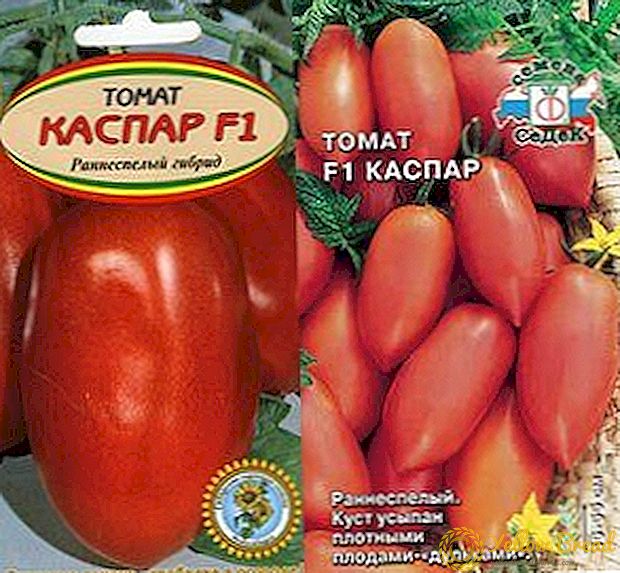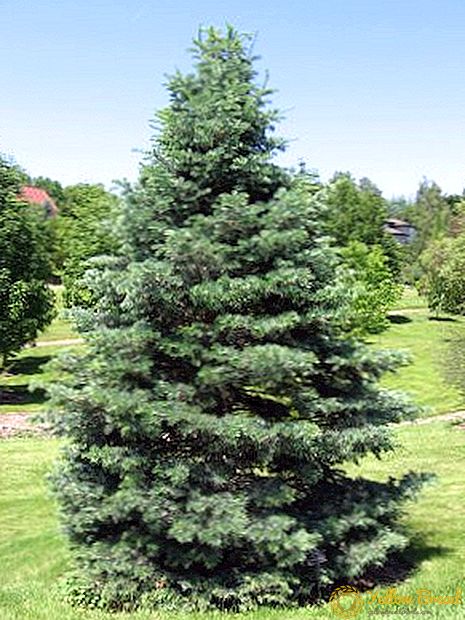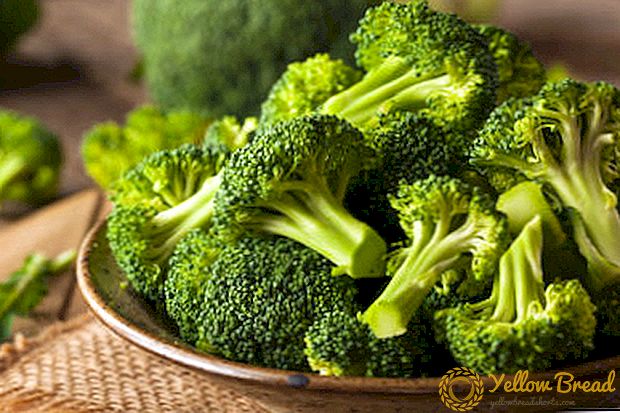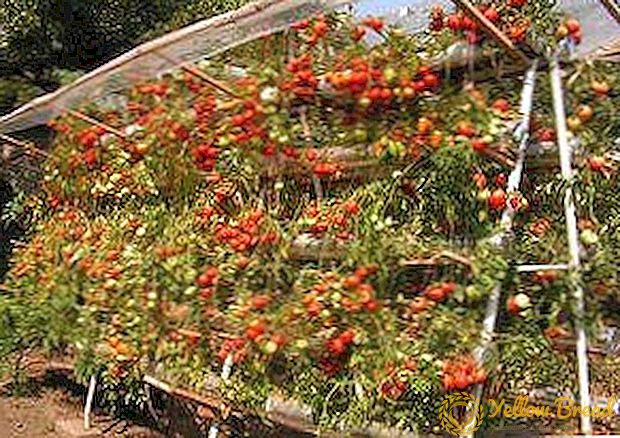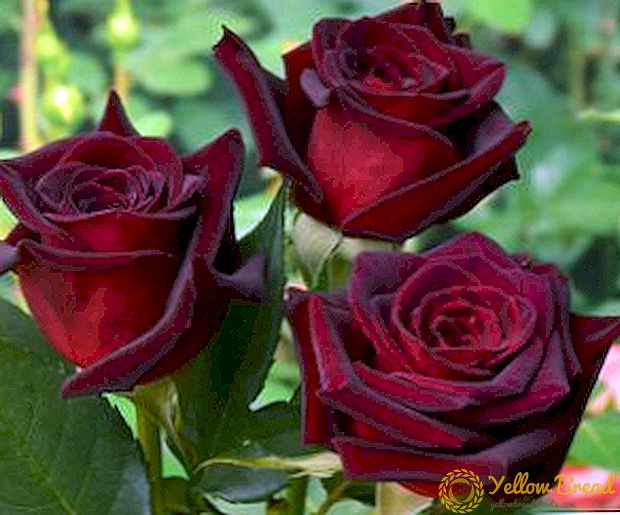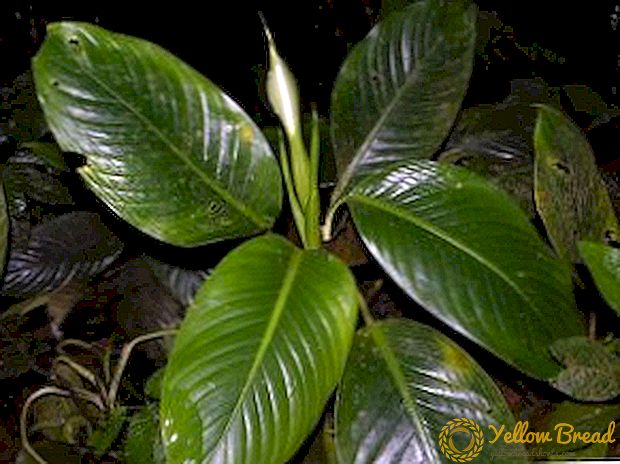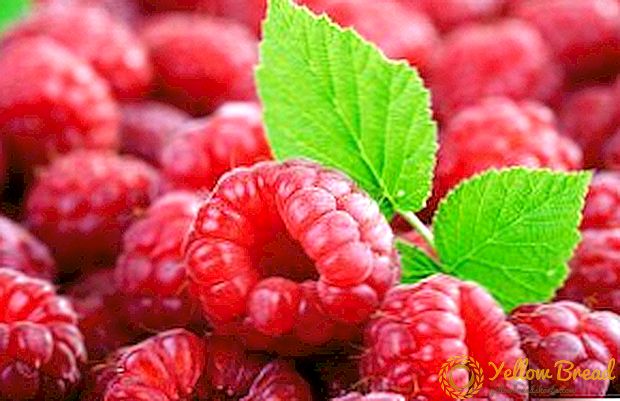 Who does not like raspberries? This berry has long won the glory of an unusually tasty, beautiful, bright and healing fruit. We associate it with the hot summer and, of course, the winter period. After all, it is the duty of every self-respecting mistress to roll up their own recipe for raspberry jam from a cold. That is why scientists annually produce more and more new varieties of this plant.
Who does not like raspberries? This berry has long won the glory of an unusually tasty, beautiful, bright and healing fruit. We associate it with the hot summer and, of course, the winter period. After all, it is the duty of every self-respecting mistress to roll up their own recipe for raspberry jam from a cold. That is why scientists annually produce more and more new varieties of this plant.
Let's talk about one of the representatives of the raspberry species - variety "Bell", its description, features, disadvantages and advantages.
- Variety selection
- Description of the bush
- Fruit Description
- Lighting Requirements
- Soil requirements
- Flowering period
- Gestation period
- Yield
- Transportability
- Resistance to environmental conditions and diseases
- Winter hardiness
- Use of berries
- pros
- Minuses
Variety selection
Siberia became native to the "Kolokolchik". It was there that he was obtained by pollination of a free kind of raspberry variety "Carnival". This was done by scientists-breeders of the Research Institute named after M. A. Lisavenko of the region. This raspberry was accepted to the process of state variety testing back in 1982. In 1991, Kolokolchik was officially included in the state registration list of the West Siberian region. Soon this variety began to appear in other areas and even countries.  Thanks to winter hardiness, raspberries can be found in Russia, Ukraine, Belarus, Romania, other countries of Asia, America and Europe.
Thanks to winter hardiness, raspberries can be found in Russia, Ukraine, Belarus, Romania, other countries of Asia, America and Europe.
Description of the bush
The representative of the variety "bell" - a plant of medium height. In standard conditions it is presented in the form of a bush tree, reaching a maximum of 2 meters in height. The plant is thick, spreading with erect stems. The shoots of the first year will surely have abundant thorns, in the second year there will be practically no thorns, and the shoots themselves will become stiffer. Grassy young branches are very resilient, resilient and strong. 
The bush is covered with green leaf. It has the shape of an oval, petiolate, slightly pubescent with hairs.The root system of the shrub is perennial, fairly thick and powerful, and can go deeper into the earth by 40 centimeters. The life cycle of the above-ground part of the shrub is limited, but new old ones always grow to replace the old dying shoots. Rhizome gives shoots of two types: reproduction and replacement.
Raspberry flowers have a white tint, reaching up to 1 centimeter in diameter. They gather in small dense inflorescences. The variety is an excellent honey plant. According to statistics, from 1 hectare of the garden bees are able to bring about 50 kilograms of honey. The very process of collecting nectar increases the yield of raspberries by 60-100%.
Fruit Description
The variety is good because it is self-fruited. In addition, raspberry bush differs incredibly beautiful red fruits, which are slightly similar when ripe on a bell. Hence the name of the variety. This is a hairy drupes. The berries are large, can reach a mass of 2 to 6 grams. The shape of the fruit is conical.
Breeders note that the positive feature of the "Bluebell" is the fact that the berries never crumble, unlike other varieties of raspberry shrubs. This means that after assembly, they will last longer and have an excellent presentation. The taste of fruit varieties good, sweet and sour. Berries have a wonderful aroma. Raspberry fruit for 70-85% consists of juice. 
Lighting Requirements
Any plant that bears berries, loves sunshine, and raspberries are no exception. For landing the "Bell" is desirable to choose a place with maximum illumination. This will ensure the timely ripening of fruits, their pleasant taste, as well as the harmonious development of the bush itself. If the light of a raspberry is not enough, its shoots will soon begin to stretch and shade branches with fruits. Thus, the berries will not sing, and spoil. For this reason, it is necessary to ensure that the bush is not too thick. Raspberries in the spring decided to “clean” from old branches and excessive young shoots.
Soil requirements
The "Bellflower" variety has a tendency to grow well in light, fertilized soil, but it is not particularly picky. It will be good to bear fruit in black soil, loam and even clayey soil. Soil acidity should be moderate: from 5.7 to 6.6.
Flowering period
In cold areas, the raspberry bush usually blooms from late June to July, sometimes even August. In warmer latitudes, the variety will delight in flowering from the beginning of June. 
Gestation period
Berries "Bell" ripen in the middle of July. This period may last until August. The speed and time of ripening depends on the weather conditions and the chosen landing site. Fruiting varieties rather long.
Yield
The harvest at this raspberry will be plentiful and will pleasantly surprise you. The fruiting season will include from 4 to 7 fees, depending on the size of the shrub itself. During this period, you can get 2-8 kilograms of berries.
Transportability
Although the fruits of the "Kolokolchik" variety are juicy and delicate in taste, their structure is rather dense. That is why these berries belong to the type of well transportable products, but at a certain temperature and container.The main thing is that the storage conditions are not violated. Otherwise, raspberries instantly pour juice and spoil.
Resistance to environmental conditions and diseases
The variety is perfectly resistant to drought, but it is necessary to water it for the period of flowering and fruiting. Raspberries well perceive frequent, but not very abundant watering. So the fruits will be bigger and tastier. The plant does not like stagnant water, it may start to rot from its excess. The "bell" extremely rarely affects the spider mite. If you plant a variety in places with steep slopes or in a low-lying area, the risk of catching the disease by the plant will increase significantly. 
Raspberries can suffer from drafts, so experienced gardeners are advised to plant other plants near it, but not too high so that they do not block the ingress of sunlight.
Winter hardiness
Since the variety was bred specifically for the conditions of Siberia, it is not afraid of the cold. It is frost resistant to a temperature that drops to -27 ° C.
Use of berries
Variety "Bell" refers to the universal. Berries can be used fresh, decorate them sweet and salty dishes. If desired, from this raspberry it is possible to make decent jelly, compote, sorbet, ice cream, jelly or any other dessert. Among jam, raspberry is considered to be the most useful. It contains vitamins of groups A, C, B, malic, citric tartaric and salicylic acids, glucose, pentose, nitrogenous substance. Raspberry fruit is a low-calorie product.
Berries are often used to create masterpieces of high cuisine - sauces for meat. Raspberry puree is often found as a side dish on the menu of fine French restaurants. Ukrainian and Russian cuisines love to put this ingredient in pies, cakes and other pastries as a filling. 
Raspberry wine, tincture, liquor have become a favorite drink for many women.Europeans often prepare such products at home. Berry is the perfect ingredient for non-alcoholic cocktails. For example, milk, mors, lemonade. Traditional medicine in different formulations recommends using raspberry berries for colds, flu, as prevention of cardiovascular diseases, to improve the functioning of the liver and kidneys, with gout, rheumatism, and arthrosis. 
As with any other product, this berry has contraindications to use. That is why if you suffer from diseases of the gastrointestinal tract, do not forget to consult with your doctor. Do not abuse the popular recipes, self-medication can harm your health.
Advantages and disadvantages
Let's talk about the advantages and disadvantages of the raspberry variety "Bellflower", which, unfortunately, is not suitable for everyone.
pros
The unquestionable advantages of this bush include:
- Winter hardiness
- Resistance to spider mite damage.
- High, early and long-term yield.
- Big size berries.
- Good taste, presentation and delicate aroma of raspberry.
- Good transportability.
- The healing properties of fruits and leaves.
- Self-fertility.
- Melliferous.
- A wide scope of the fetus.
- Low soil composition requirements.
- Fruits do not tend to fall.

Minuses
Significant disadvantages of the "Bellflower" shrub include:
- Extreme light-loving.
- Intolerance of stagnant water.
- The need for regular pruning.
- Draft fear.

